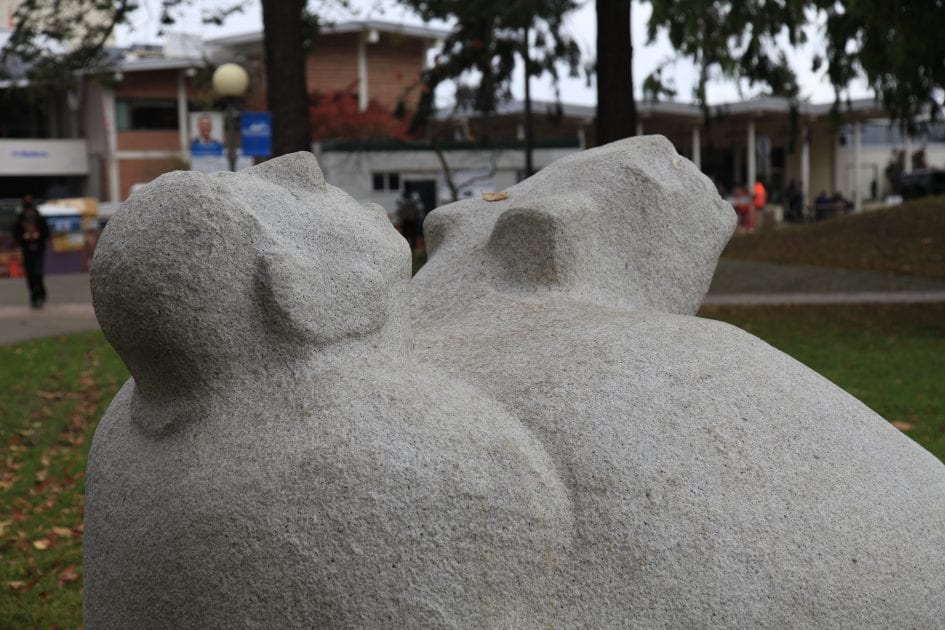The Man and The Cougar
Born in 1925, Richard Beyer was a World War II veteran as well as an artist. His works focused on nature, using animals and humans to convey stories through their poses and facial expressions. Beyer’s art tended to challenge people’s typical assumptions, and appealed to people of all ages and all walks of life. His most popular work is Waiting for the Interurban, located in the Fremont neighborhood of Seattle, Washington. Waiting for the Interurban was sculpted out of cast aluminum in 1979, seven years after The Man Who Used to Hunt Cougars for Bounty, and “…commemorates the light rail Interurban line that used to connect downtown Seattle with all of its neighborhoods” (Fremont 1) . Waiting for the Interurban depicts six people and a dog with a human face standing under a shelter. Apparently, the dog’s face is of Arman Napoleon Stepanian, who was the unofficial mayor of the neighborhood of Fremont in the 1970’s. Stepanian has been dubbed “the godfather of recycling” due to his focus on recycling in his community, and effort to incorporate environmentalism in his local community. Waiting for the Interurban has become a local landmark because of the fact that people often decorate it in costumes or with props, which has become somewhat of a tradition for celebrations in the area.
Beyer’s fame is unfortunately little known outside of the pacific northwest: his artwork is mainly in Washington and Oregon. He began his sculpting career after moving from New York to Seattle with his wife, Margaret, and their children, to pursue a PhD in economics at the University of Washington after becoming friends with a professor that taught there. In between studying, he decided to take up making toys for his kids, and purchased his first carving set from the University Bookstore. Later, he realized schooling was no longer what he wanted, and began a short career at Boeing as an engineer. He felt the work was boring (and frequently carved totem poles out of pencils), and did not support the fact that Boeing was working on war machines, which went against his own anti-war beliefs. Upon quitting his job as an engineer, he decided to attempt to establish an art career as a sculptor in the growing Seattle art scene. After a few small pieces were shown and sold in a gallery, he began attracting attention, especially from Fred Bassetti, a local architect. Beyer began to create so many pieces that they quickly ran out of room in their house for them all, and began to give sculptures away to friends. In 1963, he began to experiment with making larger works, and created The Peace Wolf: a large statue of a wolf looking down, rather than snaring or howling, to depict inner peace and thoughtfulness. The Peace Wolf was created from cedar driftwood found on a beach, and was sold to a local family.
Beyers is known for his variety of sculptures. He is famous for using humor to assess the human condition. He does this by making fun of things in a sense, or making something in a certain way to the point where he knows how our human instinct would interpret such things. At first glance this sculpture is not what it seems: many know it as “the man humping the bear” sculpture. Beyers incorporated his existing knowledge of history, poetry, folklore, myths, social, and political changes into his work. Beyers also has a variety of sculptures at elementary, middle, and high schools as well as a few universities including Western Washington University. The sculpture “The Man Who Used to Hunt Cougars for Bounty” was made in 1972 and shortly after placed on Western Washington University’s campus. During that time period there were anti war protests, various political scandals, and racial issues. Art in the 1970s sparked the beginning of the postmodernism era. In this time frame feminist art, funk art, and photorealism were very popular forms of art. Beyers valued “the things that make being alive worthwhile: family and friends, work and caring. Conversely I mock the things that debase us: greed, sloth, indifference and complacency” (Richard Beyers). The backstory behind his sculpture “The Man Who Used to Hunt Cougars for Bounty” was that there was a man who loved to hunt cougar for bounty, and eventually he couldn’t anymore. The man took to drinking, with the cougar in his lap as his “bounty” and they are drinking and singing ‘America’, explaining their open mouths and facial expressions. This could have related to the Vietnam War going on at the time. The man being a hunter and singing ‘America’ could possibly imply a relationship between the time frame and artwork.
In this video we aimed to create a visual that made the viewer feel as though they were standing at the site of the sculpture themselves. There are few intricate details of the sculpture, so standing farther away rather than up close can help to analyze the sculpture easier.
Bibliography
“Rich Beyer Sculpture.” Rich Beyer Sculpture, www.richbeyersculpture.com/.
The Early Years, www.richbeyersculpture.com/Bio/TheEarlyYears/birth_seattle.html.
“The Man Who Used to Hunt Cougars for Bounty.” Wwupedia Wiki, wwupedia.wikia.com/wiki/The_Man_Who_Used_to_Hunt_Cougars_for_Bounty.
Thompson, Lynn. “’Waiting for the Interurban’ Sculptor Richard Beyer Dies at 86.” The Seattle Times, The Seattle Times Company, 13 Apr. 2012, www.seattletimes.com/seattle-news/obituaries/waiting-for-the-interurban-sculptor-richard-beyer-dies-at-86/.
“Waiting for the Interurban.” Fremont, Seattle, fremont.com/explore/sights/waiting-for-the-interurban/.
Video and voiceover by Molly Todd
Music by Bensound.com
Photos by Rowan Westwoood
Group Members: Hailey Stapp, Rowan Westwood, Molly Todd






Leave a Reply